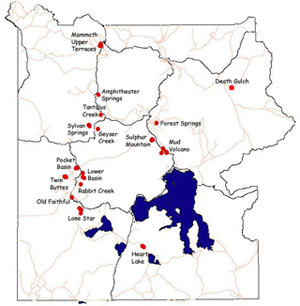
PLANTS GROWING IN HABITATS WITH NATURALLY HIGH CARBON DIOXIDE CONCENTRATIONS. . .USING GAS VENTS IN YELLOWSTONE TO HELP PROJECT THE EFFECTS OF GLOBAL WARMING
Click here to see our survey results
|
Within the next 100 years, atmospheric CO2 concentration is projected to double or even triple, mainly due to the burning of fossil fuels. Because of complex interactions between the atmosphere, plants, soil microbes, the ocean, and weather patterns, it is extremely difficult to predict how much global warming will be caused by this CO2 increase. For example, increased atmospheric CO2 may stimulate some plants to photosynthesize more rapidly, allowing them to absorb more CO2 and potentially reduce global warming. But some studies suggest that photosynthetic rates only increase briefly when CO2 supply is increased. Experiments have shown that when high CO2 concentrations are maintained for several years, plants develop physiological changes that allow them to throttle back their photosynthetic machinery. Basically, plants develop ways to work less and still produce the same amount of food for themselves. Sometimes they end up absorbing less CO2 than they did before the experiment.
Most of the research in this area has relied on relatively short-term experiments (less than ten years), so nobody knows what will happen when we conduct a long-term experiment on our planet by making increased atmospheric CO2 a permanent fact. Will plants absorb a lot of the CO2 and stored it in wood or leaves for us? Or will most of the plants actually be photosynthesizing less, making the problem worse? |
These questions are complicated by the fact that the the ways in which plants respond to changing CO2 concentration usually affect how much water the plants need and how efficiently they use nitrogen and other nutrients. These fundamental changes in how plants make their living will lead to shifts in which species can grow in certain areas, the fertility of soils, and genetic changes in plant communities that affect how they evolve in the long-term. In 100 years, most plant communities will probably be dominated by different species, and this will have profound effects on the entire ecosystem, influencing where animals can live and how much food can be grown in certain areas.
Plants growing near gas vents in Yellowstone National Park are ideal for studying the effects of atmospheric CO2 increase because they have had plenty of time to adapt their environment. Unlike the short-term experiments that have produced confusing results, studies conducted in Yellowstone's high carbon dioxide habitats take advantage of conditions that have been in place for hundreds or even thousands of years. Differences in plant physiology detected near the vents are not due to a short-term shock to the plants' system or an attempt to equilibrate to new conditions, they are adaptations that have evolved to maximize the plants' fitness to a high CO2 environment. These adaptations are likely similar to those that will be found worldwide in 100 years.
We have recently completed an extensive survey of Yellowstone's back-country and have found numerous sites that are ideal for future research. We are currently conducting physiological studies in some of these sites, but we have decided to share the survey data in the hope that will inspire additional researchers to take advantage of the unique opportunities presented by Yellowstone's high CO2 habitats.

